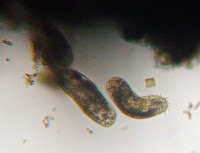
The shot below(on the far left) is a shot of the area at the bottom of the tank. The area is littered with filamentous organisms and a worm that was swimming amidst it all.

 These are pictures of the organisms attached to plant B that I refer to later in the blog. They are bladders that trap food for the plant.
These are pictures of the organisms attached to plant B that I refer to later in the blog. They are bladders that trap food for the plant.
The most interesting development in my aquarium over the past week is the effects of MicroAquarium life on plant B. It has gone from green, lush and leafy to a smaller, browner plant. It has lost color, mass and the organisms that once lived around it have changed. It is now surrounded more by excess free-floating matter in the aquarium with only a few of the dandilion-like organisms observed last week. Also, there are a few filamentous organisms and some very small rotifers.
It has, however, developed interesting growths that look pear-shaped and hollow with long, stringy, attachments off the smaller end. I originally thought they might be organisms living on the plant, but I think they may be part of the plant that it has developed over the past few weeks. I then found out that they are bladders that trap food for the plant to feed on. The bladders are green and translucent and grow within close proximity with each other.





